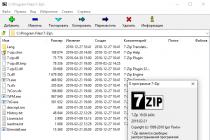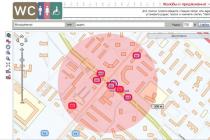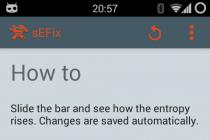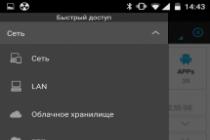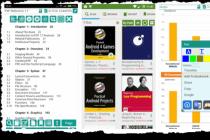Parameters of elements of the design system information technology interdependent. Considering the main characteristics of technological processes of data processing, generalized indicators are used with their further detailing at other levels of analysis of the data processing system. These parameters include: the economic effect of the automation of OD data processing; capital expenditures for computing and organizational equipment; the cost of designing OD technological processes; resources on ...
Share your work on social media
If this work did not suit you at the bottom of the page there is a list of similar works. You can also use the search button
Other similar works that may interest you. Wshm> |
|||
| 5866. | Economic information, economic document | 39.63 KB | |
| Economic information economic document Economic information Information theories adopted in cybernetics and other technical spheres have not become widespread in information processing for managing economic objects. Thus, the definition of economic information can be formulated as follows ... | |||
| 7531. | Computer science and information. Discrete and analog information | 171.29 KB | |
| 10479. | Information. Information in computer science | 44.16 KB | |
| What does this concept mean? It consists of two parts. This is informatics as a whole - the science of information, its storage, creation and transformation. Then this subject was taught even without a computer and any technical means and its purpose was only an introduction to the world of computers and computing technology and an explanation of the theoretical principles of information processing to schoolchildren. Currently, every year the amount of information we receive is increasing; it is believed that for 810 years all over the world the amount of information increases by 2 ... | |||
| 9078. | Computer science and information | 171.29 KB | |
| The emergence of informatics is due to the emergence and spread of a new technology for collecting, processing and transmitting information associated with fixing data on computer media. As part of the main task today, one can single out such main areas of informatics for practical application: architecture of computing systems, techniques and methods for constructing systems for automatic data processing; interfaces of computing systems; techniques and methods for managing hardware and software; programming... | |||
| 10321. | Information and business | 42.3 KB | |
| Information and business. Information business concept. Structural and functional model of information business. New organizational forms of information business. | |||
| 7706. | Additional reporting information | 117.32 KB | |
| Segment reporting basics 10. Information about discontinued operations and non-current assets held for sale IFRS 5 Disposals of non-current assets held for sale and discontinued operations The IFRS 5 was issued by the Board of the International Financial Reporting Standards Board as part of the program of convergence of IFRS and US national accounting standards CAAP US. The introduction of IFRS 5 will provide users of financial statements useful information to accept reasonable ... | |||
| 6617. | Initial information about the part | 11.4 KB | |
| Initial information about the part As it was noted, the computer-aided design of the TP begins with the analysis of the drawing of the part. After that, a variable initial or input information is formed - information about the part for which it is necessary to design the TP. Classification and coding of information about a part Classification is the division of a set of objects into subsets on the basis of taking into account the common features of objects and natural relationships between them. The part coding process consists in assigning a part of a digital code to a classification ... | |||
| 10377. | Information in the material world | 296.45 KB | |
| Observing the radiation of distant stars, a person receives a certain stream of data, but whether this data becomes information depends on many more circumstances. As a result, we measure the amount of its movement during the run, this is data logging. Even if the stopwatch directly displays the time in seconds and we do not need a recalculation method, then the data conversion method is still present, it is implemented by special electronic components and works automatically without our participation. Listening to a radio station broadcast on an unfamiliar ... | |||
| 6209. | Marketing information and marketing research | 11.95 KB | |
| Obtaining complete and reliable information about its state and development is one of the main goals of marketing, supplemented by the requirement to ensure the predictability of its further development, otherwise scientifically grounded forecasting of the forecast. a set of methods for observation and analysis; Collection, processing and storage of information; formation of an information bank; Analysis, modeling and forecasting of data; formation of a bank of models; drawing up conclusions and recommendations; Evaluation of the effectiveness of marketing research. The following is known ... | |||
| 955. | Marketing information: types, meaning | 57.03 KB | |
| The concept and principles of marketing information. Typology of marketing information. Sources of marketing information. Overview of the marketing information market The relevance of the topic is due to the fact that one of the key issues of the enterprise is to obtain complete reliable and timely information about the state of the marketing environment. | |||
Send your good work in the knowledge base is simple. Use the form below
Students, graduate students, young scientists who use the knowledge base in their studies and work will be very grateful to you.
- Introduction 3
- 5
- 5
- 5
- 10
- 10
- 12
- 2.3 Automatic Methods of Collecting and Recording Data 13
- 17
- Conclusion 22
- Bibliography 24
Introduction
The technology of electronic processing of economic information includes a man-machine process of executing interrelated operations proceeding in an established sequence in order to transform the initial (primary) information into the result. An operation is a complex of technological actions performed, as a result of which information is transformed. Technological operations are varied in complexity, purpose, implementation technique, performed on various equipment, by many performers. In the conditions of electronic data processing, operations that are performed automatically on machines and devices that read data, perform operations according to a given program in automatic mode without human intervention or retaining the functions of control, analysis and regulation for the user.
The construction of the technological process is determined by the following factors: the features of the processed economic information, its volume, the requirements for the urgency and accuracy of processing, the types, quantity and characteristics of the technical means used. They form the basis for the organization of technology, which includes the establishment of a list, the sequence and methods of performing operations, the order of work of specialists and automation equipment, the organization of workplaces, the establishment of time regulations for interaction, etc. The organization of the technological process should ensure its efficiency, complexity, reliability of functioning, high quality of work. This is achieved by using a systematic approach to the design of technology for solving economic problems. At the same time, there is a complex interconnected consideration of all factors, ways, methods of constructing technology, the use of elements of typification and standardization, as well as the unification of technological processes.
1. Technology of automated processing of economic information
1.1 Principles of processing economic information
The technology of automated processing of economic information is based on the following principles:
* integration of data processing and the ability of users to operate in the operation of automated systems for centralized storage and collective use of data (data banks);
* distributed data processing based on advanced transmission systems;
* rational combination of centralized and decentralized management and organization of computing systems;
* modeling and formalized description of data, procedures for their transformation, functions and jobs of performers;
* taking into account the specific features of the object in which the machine processing of economic information is implemented.
1.2 Types of organization of technological processes
There are two main types of organization of technological processes: subject and operational.
Subject type organization of technology involves the creation of parallel operating technological lines specializing in information processing and solving specific sets of tasks (labor and wages accounting, supply and sales, financial transactions, etc.) and organizing operational data processing within the line.
Operational (flow) type construction of a technological process provides for the sequential transformation of the processed information, according to the technology, presented in the form of a continuous sequence of replacing each other operations performed in an automatic mode. This approach to the construction of technology turned out to be acceptable when organizing the work of subscriber points and automated workstations.
The organization of technology at its individual stages has its own characteristics, which gives rise to the separation of out-of-machine and intra-machine technology. Out-of-machine technology(it is often called pre-base) combines the operations of collecting and recording data, recording data on computer media with control. Intra-machine technology is connected with the organization of the computing process in the computer, the organization of data arrays in the memory of the machine and their structuring, which gives reason to call it also intra-base. Considering that the subsequent chapters of the textbook are devoted to the means that make up the technical base of the out-of-machine and intra-machine information transformation, we will briefly consider only the features of the construction of the named technologies.
The main stage of the technological process is associated with the solution of functional problems on a computer. Intra-machine technology for solving problems on a computer, as a rule, implements the following typical processes of transforming economic information: the formation of new arrays of information; ordering of information arrays; fetching some part of records from an array, merging and splitting arrays; making changes to the array; performing arithmetic operations on attributes within records, within arrays, over records of several arrays. The solution of each individual task or complex of tasks requires the following operations: input of the program for the machine solution of the problem and its placement in the computer memory, input of initial data, logical and arithmetic control of the entered information, correction of erroneous data, arrangement of input arrays and sorting of the input information, calculations according to the given algorithm, receiving output arrays of information, editing output forms, displaying information on the screen and on machine media, printing tables with output data.
The choice of one or another technology option is primarily determined by the space-time characteristics of the tasks being solved, the frequency, urgency, requirements for the speed of message processing and depends both on the mode of interaction between the user and the computer dictated by practice, and the mode capabilities of technical means, primarily computers.
There are the following modes of interaction between the user and the computer: batch and interactive (query, dialogue). The computers themselves can function in different modes: single and multiprogram, time sharing, real time, teleprocessing. At the same time, the goal is to meet the needs of users in the maximum possible automation of solving various problems.
Batch mode was the most common in the practice of centralized solution of economic problems, when a large proportion of the analysis of production and economic activities of economic objects of different levels of management.
The organization of the computational process in batch mode was built without user access to a computer. Its functions were limited to the preparation of initial data on a complex of information-related tasks and their transfer to the processing center, where a package was formed that included a computer task for processing, programs, initial, normative-pricing and reference data. The package was entered into a computer and implemented in an automatic mode without the participation of the user and operator, which made it possible to minimize the execution time for a given set of tasks. At the same time, the operation of the computer could take place in a single-program or multi-program mode, which is preferable, since the parallel operation of the main devices of the machine was ensured. Batch mode is currently being implemented for email.
Interactive mode provides for direct interaction of the user with an information-computing system, may be of the nature of a request (usually regulated) or a dialogue with a computer.
The query mode is necessary for users to interact with the system through a significant number of subscriber terminal devices, including those remote at a considerable distance from the processing center. This need is due to the solution of operational tasks, which are, for example, marketing tasks, tasks of personnel reassignment, tasks of a strategic nature, etc. In such cases, a computer implements a queuing system, operates in a time-sharing mode, in which several independent subscribers (users) with the help of input-output devices have direct and practically simultaneous access to a computer in the process of solving their problems. This mode makes it possible to provide each user with time to communicate with the computer in a differentiated manner in a strictly established manner, and after the end of the session, turn it off.
Dialogue mode allows the user to directly interact with the computing system at an acceptable pace of work, implementing a repetitive cycle of issuing a task, receiving and analyzing a response. In this case, the computer itself can initiate a dialogue, informing the user of a sequence of steps (providing a menu) to obtain the desired result.
Both types of interactive mode (inquiry, dialog) are based on the operation of computers in real time and teleprocessing modes, which are a further development of the time sharing mode. Therefore, the prerequisites for the functioning of the system in these modes are: firstly, permanent storage in computer memory devices necessary information and programs, and only in a minimal volume the input of the initial information from the subscribers and, secondly, the availability of the appropriate means of communication with the computer for subscribers to access it at any time.
2. Automated processing of economic information
2.1 Economic information and its processing
Economic information is a transformed and processed set of information that reflects the state and course of economic processes. Economic information circulates in the economic system and accompanies the processes of production, distribution, exchange and consumption of material goods and services. Economic information should be considered as one of the varieties of management information.
Economic information can be:
- manager (in the form of direct orders, planned assignments, etc.);
- informing (in reporting indicators, performs the function of feedback in the economic system).
Information can be viewed as a resource similar to material, labor and monetary resources. Information resources - a set of accumulated information recorded on material carriers in any form that ensures its transmission in time and space for solving scientific, industrial, managerial and other tasks.
Collection, storage, processing, transmission of information in numerical form is carried out using information technology. The peculiarity of information technologies is that in them both the subject and the product of labor is information, and the tools of labor are the means of computer technology and communication.
The main goal of information technology is the production of information necessary for the user as a result of targeted actions for its processing.
It is known that information technology is a set of methods, production and software and technological means, united in a technological chain that provides collection, storage, processing, output and dissemination of information.
From the point of view of information technology, information requires a material medium as a source of information, a transmitter, a communication channel, a receiver and a recipient of information.
The message from the source to the recipient is transmitted through communication channels or through the medium.
Information is a form of communication between managed and controlled objects in any control system. In accordance with the general theory of control, the control process can be represented as the interaction of two systems - control and control.
The accuracy of the information ensures its unambiguous perception by all consumers. Reliability determines the permissible level of distortion of both incoming and resultant information, at which the efficiency of the system's functioning remains. Efficiency reflects the relevance of information for the necessary calculations and decision-making in the changed conditions.
In the processes of automated processing of economic information, various types of data that characterize certain economic phenomena act as an object undergoing transformation. Such processes are called technological processes AOEI and represent a set of interrelated operations proceeding in an established sequence. Or, in more detail, it is the process of converting the initial information into the output using technical means and resources.
Rational design of technological processes of data processing in EIS largely determines the effective functioning of the entire system.
The entire technological process can be subdivided into the processes of collecting and entering the initial data into the computer system, the processes of placing data and storing it in the system memory, the processes of data processing in order to obtain results and, the processes of issuing data in a form that is convenient for the user to perceive.
2.2 Process steps
The technological process can be divided into 4 enlarged stages:
1. - initial or primary (collection of initial data, their registration and transfer to the WU);
2. - preparatory (reception, control, registration of input information and its transfer to a machine medium);
3. - main (directly processing information);
4. - final (control, release and transfer of result information, its reproduction and storage).
Depending on the technical means used and the requirements for the information processing technology, the composition of the operations of the technological process also changes. For example: information on a VU can arrive at a MN, prepared for input into a computer, or transmitted through communication channels from the place of its origin.
Data collection and recording operations are carried out using various means.
Distinguish:
-mechanized;
-automated;
2.3 Automatic spos data collection and logging events
1). Mechanized- collection and registration of information is carried out directly by a person using the simplest devices (scales, counters, measuring containers, time recording devices, etc.).
2). Automated- the use of machine-readable documents, registering machines, universal collection and registration systems that ensure the combination of the operations of generating primary documents and receiving machine media.
3). Auto- used mainly in real-time data processing.
(Information from sensors that take into account the progress of production - production output, raw material costs, equipment downtime, etc. - goes directly to the computer).
Technical means of data transmission include:
- data transmission equipment (APD), which connects data processing and preparation facilities with telegraph, telephone and broadband communication channels;
- devices for interfacing a computer with an ATM, which control the exchange of information - data transmission multiplexers.
Recording and transmission of information via communication channels in a computer has the following advantages:
- simplifies the process of generating and controlling information;
- the principle of one-time registration of information in the primary document and the machine medium is observed;
- high reliability of the information supplied to the computer is ensured.
Remote data transmission based on the use of communication channels is the transmission of data in the form of electrical signals, which can be continuous in time and discrete, i.e. be discontinuous in time. The most widely used are telegraph and telephone communication channels. Electrical signals transmitted over the telegraph communication channel are discrete, and over the telephone - continuous.
Depending on the directions in which information is sent, communication channels are distinguished:
- simplex (transmission is in one direction only);
- half-duplex (at each moment of time, either transmission or reception of information is performed);
- duplex (transmission and reception of information are carried out simultaneously in two opposite directions).
Channels are characterized by data transmission speed, reliability, transmission reliability.
The transmission rate is determined by the amount of information transmitted per unit of time and is measured in baud (baud = bits / sec).
Telegraph channels(low speed - V = 50-200 baud),
telephone(medium speed - V = 200-2400 baud), and
broadband(high-speed - V = 4800 baud or more).
When choosing the best way to transfer information, the volumetric and time parameters of delivery, requirements for the quality of transmitted information, labor and cost costs of information transmission are taken into account.
Speaking about technological operations of collecting, registering, transmitting information using various technical means, it is necessary to say a few words about scanning devices.
Entering information, especially graphical information, using a keyboard in a computer is very laborious. Recently, there have been trends in the use of business graphics - one of the main types of information, which requires prompt input into a computer and providing users with the ability to form hybrid documents and databases that combine graphics with text. All these functions in a PC are performed by scanning devices. They implement the optical input of information and its conversion into digital form with subsequent processing.
For the IBM PC, the PC Image / Graphix system has been developed, designed for scanning various documents and transferring them through communications. Among the documentary carriers of the system, which can be scanned by a camera, are: text, line drawings, photographs, microfilms. PC-based scanning devices are used not only for text input and graphic information, but also in control systems, processing letters, performing various accounting functions.
For these tasks, the most widely used methods of encoding information with bar codes. Scanning of bar codes for entering information into a PC is carried out using miniature scanners resembling a pencil. The scanner is moved by the user perpendicular to a group of strokes, an internal light source illuminates the area of this set directly near the scanner tip. Bar codes are widely used both in trade and at enterprises (in the time-keeping system: when reading from an employee's card, the actual hours worked, records the time, date, etc.).
Recently, more and more attention is paid to tactile input devices - a touch screen ("touch" - sensitive). Tactile input devices are widely used as public information and reference systems and systems automated learning... The US firm has developed a Point-1 touchscreen monitor with a resolution of 1024 x 1024 pixels for IBM PC and other PCs. Touch screen widely used for stock exchanges (information on the latest selling prices for shares ...).
In practice, there are many options (organizational forms) of technological data processing processes. It depends on the use of various means of computing and organizational technology in individual operations of the technological process.
The construction of a technological process depends on the nature of the tasks to be solved, the circle of users, on the technical means used, on data control systems, etc.
3. Opportunities Excel programs
Program Microsoft Excel belongs to a class of programs called spreadsheets. Spreadsheets focused primarily on solving economic and engineering problems, allow you to systematize data from any field of activity. There are the following versions of this program - Microsoft Excel 4.0, 5.0, 7.0, 97, 2000. Version 97 is considered in this tutorial. Familiarity with earlier versions will make it easy to move on to the next one.
Microsoft Excel allows you to:
· Form data in the form of tables;
· Calculate the contents of cells by formulas, while it is possible to use more than 150 built-in functions;
· Present data from tables in graphical form;
· To organize data in constructions similar in capabilities to the database.
Microsoft Excel has 12 worksheet functions used to analyze data from lists or databases. Each of these functions, which for compatibility reasons are collectively called DBFunction, takes three arguments: database, field, and criterion. These three arguments refer to the cell spacing on the worksheet that is used by this function.
Database is an interval of cells that form a list or database.
A database in Microsoft Excel is a list of related data in which rows of data are records and columns are fields. The top line of the list contains the names of each column. The reference can be specified as a range of cells or as a name corresponding to the range of the list.
Field defines the column used by the function. The data fields in the list must contain an identifying name on the first line. The field argument can be specified as text with the column name in double quotes, such as "Age" or "Harvest" in the example database below, or as a number specifying the position of the column in the list: 1 - for the first field (Tree), 2 - for the second field (Height) and so on.
Criterion is a reference to a range of cells that specify conditions for a function. The function returns data from a list that meets the conditions defined by a range of criteria. The criteria range includes a copy of the column name in the list that is being summarized. A criterion reference can be entered as a cell range, such as A1: F2 in the example database below, or as an interval name, such as Criteria. For more information about the conditions that can be used as a criterion argument, click the button.
Functions for working with databases and lists
ODDISP Estimates variance based on a sample of selected database records
ODDISPP Calculates the variance based on the entire population from the selected database records
BDPROIZVED Multiplies the values of a specific field in database records that meet a condition
BDSUMM Adds numbers in a field for database records that match a condition
Bizvlech Retrieves one record from the database that matches the specified condition
ACCOUNT Counts the number of numeric cells in a database
ACCOUNT Counts the number of nonblank cells in the database
DMAX Returns the maximum value among the selected database records
DMIN Returns the minimum value among the selected database records
DSRZNACH Returns the average of the selected database records
DSTANDOTKL Estimates the standard deviation based on a sample of selected database records
DSTANDOTKLP Calculates the population standard deviation from the selected database records
Organization of data in the program
The program file is a so-called workbook , or working folder. Each workbook can contain 256 worksheets ... By default, the version of Excel 97 contains 3 worksheets, the previous version of the program contained 16 worksheets by default. The sheets can contain both interrelated and completely independent information. A worksheet is a blank for a table.
CALCULATION BY FORMULAS
Rules for working with formulas
· The formula always begins with the = sign;
The formula can contain signs arithmetic operations+ - * / (addition, subtraction, multiplication and division);
· If the formula contains addresses of cells, then the contents of the cell are involved in the calculation;
To get the result press .
If it is necessary to calculate the data in a column using a formula of the same type, in which only the cell addresses change when moving to the next row of the table, then such a formula can be copied or multiplied to all cells of this column.
For example:
The calculation of the amount in the last column is carried out by multiplying the data from the “Price of one copy” column and the data from the “Quantity” column, the formula does not change when moving to the next row in the table, only the addresses of the cells change.
Copying the contents of cells
Select the original cell, place the mouse pointer on the edge of the frame and hold down the key and with the left mouse button move the frame to a new location. This copies the contents of the cell, including the formula.
Autocomplete cells
Select the original cell, in the lower right corner there is a fill marker, place the mouse cursor on it, it will take the form +; while holding down the left key, stretch the border of the frame to a group of cells. In this case, all selected cells are filled with the contents of the first cell. At the same time, when copying and autocompleting, the addresses of the cells in the formulas are changed accordingly. For example, the formula = A1 + B1 will change to = A2 + B2.
If the formula contains addresses that are referenced should not change, a $ sign must be specified before this address.
For example: = $ A $ 5 * A6
When you copy this formula to the next line, the reference to the first cell will remain unchanged, and the second address in the formula will change.
Calculating Column Totals
In tables, it is often necessary to count totals by column. There is a special pictogram for this. Auto-summation ... Previously, the cells with the initial data must be selected, for this we click the icon, the amount will be located in a free cell under the column.
Conclusion
The considered technological processes and modes of operation of users in the "man-machine" system are especially clearly manifested in the integrated processing of information, which is characteristic of a modern automated decision in the adoption of managerial tasks. Information processes used in the development of management decisions in automated organizational management systems are implemented using computers and other technical means. As computing technology develops, the forms of its use are also improved. There are various ways to access and communicate with computers. Individual and collective access to computing resources depends on the degree of their concentration and organizational forms of functioning. Centralized forms of using computing facilities that existed before the mass use of personal computers assumed their concentration in one place and the organization of information and computing centers (ICC) for individual and collective use (ICCKP).
Recently, the organization of the use of computer technology has undergone significant changes associated with the transition to the creation of integrated information systems. Integrated information systems are created taking into account the fact that they must carry out coordinated data management within the enterprise (organization), coordinate the work of individual departments, automate operations for the exchange of information both within individual user groups and between several organizations that are tens and hundreds of each other kilometers. The basis for the construction of such systems are local area networks (LAN). A characteristic feature of a LAN is to enable users to work in a universal information environment with shared data access functions.
In the last 2-3 years, computerization has reached a new level: computer systems of various configurations are being actively created on the basis of personal computers(PC) and more powerful machines. Consisting of several stand-alone computers with common shared external devices (disks, tapes) and a single management, they provide more reliable protection of computer resources (devices, databases, programs), increase fault tolerance, ensure ease of upgrading and increasing system capacity. More and more attention is paid to the development of not only local, but also distributed networks, without which the solution of modern problems of informatization is unthinkable.
Depending on the degree of centralization of computing resources, the user's role and functions change. With centralized forms, when the user does not have direct contact with the computer, his role is reduced to transferring the initial data for processing, obtaining results, identifying and eliminating errors. With direct communication between the user and the computer, his functions in information technology expand. All this is realized within one workplace. In this case, the user is required to know the basics of computer science and computer technology.
Bibliography
1. Gromov G.R. Essays on information technology. - M .: InfoArt, 1992.
2. Danilevsky Yu.G., Petukhov I.A., Shibanov B.C. Information technology in industry. - L .: Mechanical engineering. Leningrad. branch, 1988.
3. Dokuchaev A.A., Moshensky S.A., Nazarov O.V. Informatics tools in the office of a trading company. Means of computer communications. - SP b, TEI, 1996 .-- 32p.
4. Information technology, economics, culture / Sat. reviews and abstracts. - M .: INION RAN, 1995.
5. Information systems in economics / Ed. V.V. Dick. - M .: Finance and Statistics, 1996.
6. Klimova R.N., Sorokina M.V., Khakhaev I.A., Moshensky S.A. Informatics of a trading company / Textbook. For students of all specialties of all forms of education. - SP b .: SPbTEI, 1998 .-- 32p.
7. Computer technologies of information processing./ Ed. S.I. Nazarova - M .: Finance and Statistics, 1996.
8. Friedland A. Informatics - an explanatory dictionary of basic terms. - Moscow, Prior, 1998.
9. Shafrin Y. Information technologies, - M., LLC "Laboratory of Basic Knowledge", 1998.
Similar documents
Modes of computer data processing. Centralized, decentralized, distributed and integrated ways of processing data. Information processing facilities. Dialogue types, user interface. MS Excel spreadsheet processor.
term paper, added 04/25/2013
Information collection technology using traditional methods. Offline information collection rules. Technical means of collecting information. Operations for fast data recovery in storage systems. Technological process and information processing procedures.
term paper, added 04/02/2013
Development of a project for an automated system for processing economic information for a small advertising company. Purpose and main functions of the designed system, requirements for it. Technology for processing and protecting the economic information of an enterprise.
test, added 07/10/2009
Requirements and structure of systems for processing economic information. Information processing technology and system maintenance, information protection. The process of creating queries, forms, reports, macros and modules. Tools for organizing databases and working with them.
term paper, added 04/25/2012
Basic properties of information. The minimum unit for measuring the amount of information, its analogy with knowledge from the point of view of the cognition process. Characteristics of the main information processes: search, collection, processing, transmission and storage of information.
test, added 10/01/2011
Development of a C ++ program and implementation of the formulation and selection of algorithms for solving problems of processing economic information, creating and editing a database, sorting records by a specific request, analyzing the efficiency of data processing.
test, added 08/28/2012
Automated information processing systems. Storage of a large amount of information. The concept of a database (DB). Ensuring the secrecy of data. Levels of data presentation in the database. Logical structure data. Restrictions on data.
abstract, added 11/26/2011
Description of the organization of automated processing. Data schema and its description. Characteristics of input and output information. Organization of the technological process of collecting, transferring, processing and issuing information. Formalization of automated tasks.
term paper, added 11/22/2013
Automated information processing: concepts and technology. Organization of placement, processing, search, storage and transmission of information. Protection of information from unauthorized access. Anti-virus information protection. Network technologies.
manual, added 01/14/2009
The program for processing economic information, which carries out the input of the initial information from the file. View and edit the source data table. Internal presentation of data. Storing records of the input file. Adding and removing lines from the list.
11. Automated processing of economic information
At OJSC "ChPF" Buket Chuvashia " computer program 1C: Enterprise 7.7 revision 4.4, which can be used to maintain any sections of accounting at enterprises different types.
The various and flexible capabilities of the 1C: Enterprise system allow you to use it both as a fairly simple and intuitive tool for an accountant, and as a means of complete accounting automation from entering primary documents to generating reports.
The 1C: Enterprise system can be used to maintain almost any sections of accounting:
· Accounting for bank and cash transactions;
· Accounting for fixed assets and intangible assets;
· Accounting of materials;
· Accounting for goods, services and production;
· Accounting for foreign exchange transactions;
· Accounting for settlements with organizations, debtors, creditors, accountable persons;
· Accounting for payroll calculations;
· Accounting for settlements with the budget;
· Other sections of the account.
System 1C: Enterprise has flexible accounting organization capabilities:
1. Synthetic accounting for a multilevel chart of accounts;
2. Accounting for several charts of accounts;
3. Currency accounting and accounting for the coverage of currencies;
4. Multidimensional analytical accounting;
5. The mode of automatic generation of operations on documents.
6. In order to expand the possibilities for accounting for wages, the "Payroll" configuration was purchased to work in the 1C: Enterprise 7.7 program. Manual operation input mode;
7. Mode of typical operations;
8. The mode of automatic formation of operations on documents.
An important difference between accounting accounts and other types of data is the ability to create the accounts themselves, both in configuration and in the infobase itself.
The functioning of the 1C: Enterprise system is divided into two processes separated in time: setting (configuring) and the direct work of the user to keep records or perform calculations.
In turn, I would like to note that along with wide opportunities, this program also has disadvantages. A new software product "1C: Enterprise 8.0" has recently been released, which, in my opinion, is more convenient to use than the program "1C: Enterprise 7.7"
Most beer and non-alcoholic factories (PBK) produce not only beer and soft drinks, but also low-alcohol products. The production process at PBK is multi-stage, continuous and multi-flow. The duration of technological operations is measured in days and weeks, in some cases months. Each technological operation is characterized by duration, yield rates and quality indicators. A characteristic feature of PBK's activities is also a large volume of work in progress.
Accounting at the plant must be carried out by types of finished products - beer, mineral water, weak alcohol, soft drinks, etc. To conduct quantitative accounting of the nomenclature, you must simultaneously use several units of measurement - a bottle, a box, a container, a wagon, dal (10 liters) and a liter of anhydrous alcohol. To organize accounting for the shipment of finished products, it is necessary to take into account the "gross" and "net" weight. Write-off accounting should be organized in accordance with the rate of natural attrition. Control should be ensured for excess losses of raw materials, materials and finished products. Accounting for pledged containers should be kept in the context of customers and types of containers - wagons, containers, boxes, bottles and kegs. For the efficient operation of vehicles when delivering products, customers need to plan its work and keep records of its use.
In accordance with the requirements of the legislation, PBK must keep records of the turnover of ethyl alcohol and excise taxes, as well as submit regulated reports to the regulatory authorities.
For the automation of enterprises producing and selling beer, as well as low-alcohol and non-alcoholic products, the firms "1C" and "Comcon project" (1C: Franchisee, Moscow) jointly developed an industry-specific application solution "1C: Beer and non-alcoholic plant 8.0". This software product is developed on the basis of the "1C: Enterprise 8.0. Manufacturing Enterprise Management" program. In the process of creating the solution, the peculiarities of the PBK activity were taken into account, as well as the experience of automation of the Ochakovo MPBK and the Derbenevka Moscow yeast plant.
The program "1C: Beer and Non-Alcoholic Plant 8.0" is a complex solution and covers all the main contours of management and accounting at a production enterprise. This solution allows you to organize a unified information system for managing various aspects of the enterprise (production, purchasing, inventory and sales), for managing finances and relationships with customers and suppliers. The software product implements production planning, sales and procurement planning, cost management and costing, personnel management and payroll. Provides budgeting, accounting and tax accounting, as well as accounting in accordance with IFRS.
All documents related to the EIS, as well as the files of the in-machine information base, can be divided into input and output.
The composition of the in-machine base is determined based on the information needs of each level of the management apparatus.
In the theory of automated systems for processing economic information, IO is usually divided into:
§ systems of indicators for a given subject area (for example, indicators of accounting, financial and credit activities, analysis, etc.);
§ classification and coding systems;
§ documentation;
§ information flows - options for organizing document flow;
§ various information arrays (files) stored in the machine and on machine media and having a different degree of organization.
The most complex organization is an automated data bank, which includes arrays for solving routine tasks, issuing certificates and exchanging information between various users.
In the course of designing an IO, carried out in conjunction with users-economists, the following works are carried out:
· The composition of indicators necessary for solving economic problems, their volume-time characteristics and information links are determined;
· Various classifiers and codes are being developed; the possibility of using national classifiers is being studied;
· The possibility of using a unified documentation system for reflecting indicators is revealed, the forms of new primary documents are designed, adapted to the requirements of machine processing;
· The organization of the information fund is in progress; the composition of the database and its organization are determined; the forms for outputting the processing results are designed.
The creation of information support is carried out in close connection with the technology of automated processing and software.
The creation of the IO is carried out in the course of drawing up a technical project and provides for the preparation of instructions for users on the application of the main provisions of the IO in their practical activities related to the processing of economic tasks on a PC. It:
· Instructions for preparing documents for machine processing and their coding;
· Instructions for processing an economic task on a PC - entering a program, correcting information arrays, entering initial data, correcting information, loading into a database, organizing queries, receiving output data, organizing information exchange with other users.
Documentation and technology of its formation
The main carriers of information in automated processing are input and output documents, i.e. legal force. Input documentation contains primary, unprocessed information reflecting the state of the control object; filled in manually or using technical means.
Output documentation includes summary-grouping data obtained as a result of automated processing and is produced mainly on the printing devices of the machine. In accounting and the financial and credit system, the accepted forms of documentation are governed by uniform regulations, rules and instructions.
The development of systems for the automated processing of economic information, providing for the exchange of information, required the unification and standardization of all documentation designed to reflect economic information.
For a number of documents, uniform unified and standard forms of forms have been developed. The unification put forward the following requirements for documents: a standard form of construction, adaptation to automated processing, minimization of indicators, elimination of duplication, inclusion of all indicators necessary for management purposes.
Requirements for unified documentation prescribe documents to have a standard construction form, which provides for the allocation of three parts in the document: headline, content and design.
- Heading part contains the following characteristics of the document and the considered object:
· The name of the considered object (enterprise, organization, working);
· Characteristics of the document (index, OKUD code);
· Title of the document;
· A zone for putting down codes of permanent attributes for a document.
- Decorating part document contains signatures legal entities responsible for the correctness of its preparation, as well as the date of filling out the document.
The development of forms of primary documents is carried out in the following sequence:
· The composition of the details included in the document is being clarified; their composition should be consistent with management objectives;
Details that are subject to automated processing are highlighted and distributed in three zones:
1st zone - permanent signs, located in the heading part, in a frame for affixing permanent signs codes;
2nd zone - variable signs placed in the table to the right or left of the name of the signs;
3rd zone - quantitative-sum bases, placed in the table on the right.
The process of creating forms of primary documents is associated with the further procedure for placing the data of these documents in the computer memory. The current level of development of technology for automated information processing provides for the development of a layout for entering data from documents in 2 versions:
1. the layout of each document represents an exact copy of the original document (payment order, invoice, check, etc.);
2. a unified layout for entering data from different documents that have the same requisite composition (for example, a unified layout of a document for entering data from payment orders, expense and receipt cash orders, invoices).
The result of processing economic information is various summaries, tables, grouped according to certain criteria. The summarized data can be presented on paper, on the display, on magnetic media. The following requirements are imposed on the output documents: the composition of the indicators contained in them must be sufficient for management purposes, the data must be reliable and logically located in the document. The PC must produce ready-to-use documents: print title page, heading part, content, styling part. When placing details in the output documents, a hierarchy of grouping characteristics and totals to be calculated is established:
· Grouping signs are arranged according to the degree of decrease in the level of their subordination;
Quantitative totals - according to the degree of increase in the totals.
The development of forms for primary and summary documents is carried out at the stage of a technical project.
Intra-machine information support
Intramachine information support (ISO) includes all types of specially organized information presented in a form that is convenient for perception by technical means. These are files (arrays), databases and data banks, knowledge bases, as well as their systems. Whereas off-machine IO is a collection of messages and documents in a form perceived by the user without the use of computer technology.
IO must quickly and fully meet the information needs of all users. In terms of content, a VIO is a set of factual information used in the economic activity of an enterprise. According to their role in machining and technology of using, the arrays are divided into:
Permanent or regulatory reference ( NSI ) ... They constitute the information basis and rarely change. They include classifiers, reference books, catalogs, etc. They are formed before the start of AIS operation and are used in many cycles of information processing. It is accepted to distinguish 4 classes of reference data (normative and reference information of enterprises):
· Design staff of production facilities;
· Technological standards (technological operations, types of equipment, time rates, material consumption rates, etc.);
· Classifiers (products, etc.);
· Price tags.
Variable arrays contain actual (accounting) information that characterizes the state of the control object. This information is most often formed on the basis of primary documents;
Intermediate arrays- they arise at the stages of solving problems and do not have independent significance for management purposes;
Output (resulting) arrays are obtained as a result of processing the initial information and contain the data necessary for analysis and management decision-making.
Service arrays- contain auxiliary information necessary for processing all other types of arrays.
All types of arrays constitute the IO of a computer system and provide systematization and unification of indicators, allow to establish terminological unity, unambiguity of descriptions and relationships between indicators in the in-machine IO.
With an increase in the amount of information for multipurpose use and the effective satisfaction of the information needs of various users, an integrated approach is used to create a VIO in the form of a database or databank.
Database Is a specially organized storage of information resources in the form of an integrated set of files, which provides convenient interaction between them and quick access to data .
Database Is an automated system representing a set of information, software, hardware and personnel. Providing storage, accumulation, updating, search and delivery of data. The main components of the data bank are the database and the DBMS.
Creation of Databases and Databanks solves a number of problems:
· Eliminates multiple input and duplication of the same data;
· Reduced data redundancy and inconsistency;
There is no problem of changing application programs due to the replacement of physical devices or
Data structure changes;
· The level of reliability and security of information, convenience of access to data is increasing;
Reduced costs not only for creating and storing data, but also for maintaining them in current state;
· It becomes possible to share data to solve a wide range of tasks, including new ones.
Mathematical software
Software is a set of mathematical methods, models and algorithms for information processing used in solving functional problems. The software includes tools for modeling control processes, methods and tools for solving typical control problems, methods for optimizing the studied management processes and decision-making (methods of multi-criteria optimization, mathematical programming, mathematical statistics, queuing theory, economic and mathematical models, etc.). etc.).
The software serves as the basis for the development of a complex of applied programs.
Economic - mathematical modeling in the planning and management of an economic object
Economic - mathematical modeling (EMM) allows you to display a real economic or production system in the form of mathematical relationships between the parameters and characteristics of this system. It allows you to avoid mistakes in the implementation of planning and management tasks for an economic object. The final decision, chosen using the EMM, is the most reasonable, since it is selected from a set of feasible solutions.
Economic - mathematical models are intended not only to obtain any result in the form of a specific number, an exact value, but in many cases they are used to analyze economic processes and phenomena. Mathematical modeling allows solving problems that cannot be solved by traditional methods.
Let's list, for example, EMM used for planning and sales of products:
· Calculation of the optimal production program for enterprises with a serial type of production;
· Optimal scheduling of production consists in drawing up an optimal schedule for loading machines for the manufacture of a certain number of parts according to a given technology;
· Model of location of production of heterogeneous products, taking into account the binding of producers to consumers.
Software
There are 2 main types of software:
1. general (system): provides automation of software development and organization of the computing process;
2. special (applied) - a set of programs for solving specific user problems.
Operating system Is a program that is automatically loaded when the computer is turned on and provides the user with a basic set of commands that can be used to communicate with the computer: launch the program, format a floppy disk, copy a file, etc.
The programming system is a tool for skilled users - programmers and non-programmers. define information technologies designed to design a functional software... Functional software is a software implementation of specific functions of an information worker using various information technologies, i.e. it is setting up an automated workstation (AWP), DBMS, hypertext, multimedia, expert systems, software package tasks and subsystems of the EIS, built with the help of other design tools, for a specific information worker of a specific enterprise, taking into account the specifics of the data processing system that has developed there.
Programmer tools define the information technology available to a user with any computer and programming qualifications.
Service programs provide a number of services to ensure the operation of computers and software.
except operating systems for the functioning of any EIS, you also need:
§ text and diagnostic programs;
§ telecommunication software;
§ software tools for protecting information from unauthorized access and influences;
§ software tools for confirming the integrity of the transmitted document and identifying the author's signature;
§ programming interface with others computer systems and etc.
Organizational support
Organizational support includes a set of documents that regulate the functions and tasks of specialists using the software.
Legal support is a set of documents defining the rights and obligations of specialists using P, as well as rules for storing and protecting information, revising data. ensuring the legal authenticity of the data.
Methodological support - a set of guidelines for the implementation and use of software, training tools, demonstration examples.
Ergonomic support is a set of measures that provide the most comfortable working conditions for users.
Linguistic support - with its help, communication between a person and a machine is carried out. It includes a system of terms and definitions, information languages for describing the structural units of the information base (documents, indicators, details), language tools of information retrieval systems, etc.
Enterprise management automation
AIS for enterprise management (you can use the previously appeared definition of an automated control system or an automated control system - an automated enterprise management system. In modern literature, there is also the term AMCS - an enterprise management automation system) is a set of interrelated elements that form a single whole aimed at achieving a single goal. The goal is the systematic collection and processing of economic information, which should provide all the functions of enterprise management.
It is automation that provides the necessary control efficiency and flexibility of enterprise management, obtaining consistent and complete data on the financial and economic condition, prompt access to analytical information about the enterprise.
A clear boundary should be drawn between the ACS (accounting automation system, mainly accounting and financial, etc.) and the ACS or ACS (enterprise management automation system) - in the western terminology of the resource planning system (ERP - Enterprise Resource Management) and planning the need for manufacturing resources (MRP II - Manufacturing Resource Planning).
Enterprise management automation is based on 3 "whales":
Business Process Technology;
Technical means.
Buisness process- this is a set of internal activities of the enterprise, ending with the creation of the products necessary for the client (consumer). Business processes "permeate" the functional structure of the enterprise. Their structure reflects the interaction of departments during the production of products, while the functional structure of an enterprise reflects the distribution of responsibilities between departments. Business processes are the subject of management automation.
The difference between accounting automation systems and control automation systems is that the former cover only one control function, and the latter cover the entire process.
The technology of business processes ensures the completeness of the formation of primary data, the reliability and efficiency of accounting information within the framework of the economic activity of the enterprise, the correct design and accounting of business processes, the choice of the most rational forms and methods of management and determines the final requirements for the organization of the entire management process at the enterprise.
Management technologies are incorporated in the automated control system, which have become standard in international practice. These include:
1) Financial management - budgeting, project management, etc .;
2) Logistics management - statistical inventory management, planning requirements for distributed inventory, etc .;
3) Production management and planning
- general techniques: volumetric scheduling, planning of material requirements, planning of demand for production capacity, planning of financial resources;
- special techniques: continuous production, batch production, production "to order" and "to stock";
- specialized techniques: marketing management, quality management, Just-in-Time.
Systems for automating enterprise management differ in the level of support for these management methodologies and in the level of coverage of business processes.
Unlike Western enterprises, where automation is widely used, in Ukraine this process is just beginning, and even then not in all industries. As world experience shows, in developing economies, the use of automated control systems begins with the following industries:
- Which provide the basic needs of the bulk of the population - food industry, energy, construction, pharmaceutical industry, wholesale and retail trade, light industry;
- Which enjoy the greatest investment attractiveness - in addition to those listed above, the chemical, fuel, metallurgy, machine-building and processing industries;
- Which serve and help to form the market infrastructure - all types of communications, hotel business and tourism, banking, legal and insurance services, car service, production of auto parts, transportation, etc.
Organizational forms of SOEI
The system of automated processing of economic information (SOEI) is a system in which reliable primary (factual) information (which characterizes the production, economic or other activities of the enterprise) fixed once in the minimum volume in the rhythm of production and in the same rhythm is transmitted and processed on a computer in such a way that at the end of this process maximum result information is obtained... This information must fully satisfy all management functions and can serve to inform managers at various levels. The systematic approach involves the creation of a unified information base, providing for the use of a single source information for all management tasks, unified system classification and coding of information.
The main organizational form of using SOEI at Ukrainian enterprises is an automated control system of various levels and purposes. At large enterprises, associations, organizations, multilevel integrated automated control systems have been created.
Nowadays they are called VIAS - an in-house integrated automated system.
Depending on the specifics of production, the development goals of such an automated control system, etc., it may include several systems: an automated process control system (automated enterprise management system), an automated process control system (automated process control system), a CAD (design automation system), an automated process control system ( automated control system for technical preparation of production), ASUNIS - ACS for scientific research. All these systems can be interconnected and interdependent, and can be relatively independent. Each of these systems is divided into a number of subsystems - called functional subsystems. In turn, each subsystem has its own set of tasks and information.
ACS can include the following subsystems - MTO (material and technical support of production), BU (accounting), PMO (operational management of production), personnel management, etc. A similar structure of the ACS has developed in a planned economy. Information processing was carried out by a special subdivision of the VC or VCKP (centrally).
With the advent of PCs and communication tools, SOEIs began to be developed on the basis of AWPs (automated workstations of users) and their networks.
The functional subsystem is part of the AIS. Which is highlighted on the basis of the general functional features of enterprise management. Often in the functional structure of the AIS, the composition of the functional divisions of the enterprise is repeated. The names of these subsystems are repeated by the names of the subdivisions. Depending on the complexity of the control object, the number of functional subsystems (ps) can be 10-20 or more:
Ps accounting
Ps of management of technical preparation of production
Ps technical and economic planning
Ps of operational management of the main production
Ps material and technical supply
Ps personnel management
Ps financial management
Marketing management ps
Ps analysis of financial and economic activities
Ps investment management
Ps project management, etc.
Subsystems that are similar in functionality are combined into contours. Organizationally, each functional subsystem consists of a set of AWPs (automated workstations) of various specialists.
Functional structure - the composition of functional subsystems
Organizational structure - a set of AWPs
Modular building - the composition of the AIS modules. The module can be a separate functional subsystem, or one AWP,
or a set of tasks.
AWP - a means of automating the work of the end user
AWP is a set of information, software and technical resources that provide the end user with data processing and automation of management functions in a specific subject area. (Pp. 184-185, 67)
AWP is a tool for rationalizing and intensifying management activities. It is created to perform a certain group of functions. The following requirements are imposed on the workstation: small size, low cost, high reliability. Ability to work in standalone and network mode, providing a developed dialogue between the user and the PC, the ability to input, edit and output text documents, tables, graphs, figures.
AWPs are classified according to various criteria:
1.by the type of tasks being solved:
information and reference;
information and computing;
operational management;
accounting, etc.
2. by operating mode - in exclusive mode and network;
3. by functional orientation - ARM-T - technical and auxiliary personnel -
cash, ARM-S - specialist, ARM-R - manager;
4.According to the level of use - workstation at the lower level, workstation at the middle level, workstation at the highest
level, etc.
AWP networks, the creation of an RDB (distributed database) made it possible to switch to decentralized information processing and bring it closer to the places of origin and consumption of information.
Under these conditions, the line between the complexes of various functional subsystems began to blur - inter-functional complexes of control tasks arose. ACS is currently a network of automated workstations of different levels (mainly 2-4 - level networks). The hierarchical workstation network most fully corresponds to the production management structure.
· AWP - R (head) upper level;
· ARM-S (specialist) intermediate level;
· ARM-T (technical worker) the lowest level.
AWPs of the lowest level work in the rhythm of production, that is, when a business operation is performed and information about it is recorded in a computer. AWP more high levels work in a more "free" mode.
Characteristics and requirements for ARM-R, ARM-S, ARM-T.
ARM-R(managers: directors, chief administrators) can have a distributed (network - AWS) and local structure.
Requirements for ARM-R:
The presence of a developed database;
Providing an operational information retrieval system;
Providing operational communications and other sources of information within organizational structures;
Providing the possibility of accumulating work experience and previously made decisions in the memory of the AWS.
Typically, such AWPs include the manager's business package (electronic notebook, personal archive, file of orders).
ARM-S ( specialists: chiefs of functional services, chief specialists, chief engineers, chief technologists, etc.) - contains support systems professional activity, providing automation of routine work and support of communications.
The ARM-S contains: a database, means of electronic processing of forms and business graphics, a set of PPPs for mathematical calculations and modeling, as well as expert systems and knowledge bases to support solutions to formalized and non-formalized problems.
ARM-T(technical workers: secretaries, cashiers, storekeepers) - for employees performing routine work: 60% -70% of their working time they are busy working with documents and telephone calls. The main functions are information input, paperwork, maintaining cards and archives, processing incoming and outgoing documents (workstation-secretary, workstation-storekeeper, workstation-inspector of personnel, etc.).
Workstation network allows:
1. Ensure the interconnection of the processes of collecting and processing information horizontally (between structural units) at each level, and for each subject area (vertically);
2. Promptly and comprehensively to ensure in each subsystem and at all levels the solution of all functional issues of management;
3. Solve the problem of timely automatic generation of reliable results of the enterprise as a whole, and also obtaining consolidated financial indicators for the formation of established reporting.
Definitions of an automated workstation for a specialist (AWP). The role and place of AWP in automated information technology.
In recent years, the concept of distributed management systems of the national economy has emerged, where local information processing is provided. To implement the idea of distributed control, it is necessary to create for each level of management and each subject area of automated workstations (AWP) based on professional personal computers.
Analyzing the essence of automated workplaces, specialists most often define them as professionally oriented small computing systems located directly at the workplaces of specialists and designed to automate their work.
For each control object, it is necessary to provide for automated workstations corresponding to their functional purpose. However, the principles of creating an automated workplace should be general: consistency, flexibility, sustainability, efficiency.
According to the principle of consistency, AWPs should be considered as systems, the structure of which is determined by functional purpose.
The principle of flexibility means the adaptability of the system to possible restructuring due to the modularity of the construction of all subsystems and the standardization of their elements.
The principle of sustainability lies in the fact that the AWS system should perform basic functions regardless of the impact on it of internal and external possible factors. This means that malfunctions in its individual parts must be easily eliminated, and the system's performance must be quickly restored.
The effectiveness of the automated workplace should be considered as an integral indicator of the level of implementation of the above principles, referred to the costs of creating and operating the system.
Currently, to intensify the mental and managerial work of specialists of various professions, AWPs are being developed and widely distributed, which operate on the basis of a PC.
Let's consider the main constituent elements of the AWP for employees of economic services, management activities, etc., the prospects for their development and use. The general scheme of the PC, which constitutes the technical basis of the AWP.
External storage devices (OVC)
· Display - the main device for displaying information.
· Keyboard - the main device for entering information.
Recall that the most effective organizational form of using PCs is the creation of specific specialists (economists, statisticians, accountants, managers) on their basis, since this form eliminates the psychological barrier in the relationship between man and machine.
The accumulated experience suggests that the AWP should meet the following requirements:
· Timely satisfaction of information and computing needs of a specialist.
· Minimum response time for user requests.
· Adaptation to the level of training of the user and his professional needs.
· Simplicity of mastering the techniques of work at the AWP and ease of communication, reliability and ease of maintenance.
· Tolerance towards the user.
· The ability to quickly train the user.
· The ability to work as part of a computer network.
A generalized AWS diagram is shown in Fig. 3.

Fig 3. Scheme of an automated workstation.
Automated system for processing economic information (ASOEI) Is a complex human-machine system built on an appropriate information base, allowing to carry out all technical operations on information and created for the automation of human activity.
The purpose of creating ASOEI- creation of an integrated information system based on the use of modern information technologies for the preparation, reception, processing, transmission, accounting, search, control of economic information and documents to improve the efficiency and quality of management of economic objects.
The main purpose of ASOEI- increasing the efficiency of enterprise management, improving the efficiency of decision-making, automating information work performed by various departments and structures of the automation object.
There are the following requirements to ASOEI:
1. Building up and development. Due to the fact that the user needs changes and no software is static, the system should allow configuring the ASOEI, provide tools for the development and modification of the system.
2. Compatibility between functional blocks, as well as with other information systems - the ability to use the software, as well as the data used and generated by it in another computing environment. Achieved by having standard system commands and formats, standardization of input-output procedures, includes technical, linguistic, software, information, organizational compatibility.
3. Adaptability- the ability to change to maintain its operational capabilities when the external environment changes.
4. Convenience- the presence of a uniform friendly user interface for the tasks being solved.
5. Immunity- performance of its functions in conditions of interference.
6. Diagnosis- diagnostics of hardware and software.
A simple saturation of management bodies at all levels with computer technology without changing the methods and principles of managing the organization does not give the required result.
There are the following principles for the construction of ASOEI:
1) principle new tasks- one should not just shift traditional control methods to technology, but they need to be rebuilt in accordance with the capabilities of technology;
2) systems approach- the goals and criteria for the functioning of the facility and the information support system should be considered together;
3) the maximum possible typification of design solutions;
4) principle continuous development;
5) principle workflow automation;
6) principle unified information base.
The design of ASOEI is understood as the process of developing technical documentation related to the organization of automated information technology. The document obtained as a result of the design is called project. Design purpose- selection of technical and formation of information, mathematical, software and organizational and legal support.
Allocate four stages of development ASOEI:
1. Analysis of primary requirements and work planning. At this stage, the benefits of implementing this system and time costs are assessed, and the cost of the next step is justified.
2. Conducting a survey of the enterprise.
3. Determination of the organizational and topological structure of the enterprise, business processes, analysis of the distribution of functions by departments and employees, determination of the level of automation, and more (carried out by means of questionnaires, collection of documents).
4. Construction and analysis of business models. At this stage, 2 models are built using the IDEFO methodology: the “As is” and “As will” models. The transition from the “As is” to the “To be” model is usually accomplished in two ways: by improving technology based on performance assessment (“soft” reengineering) and by radically changing technology and rethinking the business process (“hard” reengineering).

